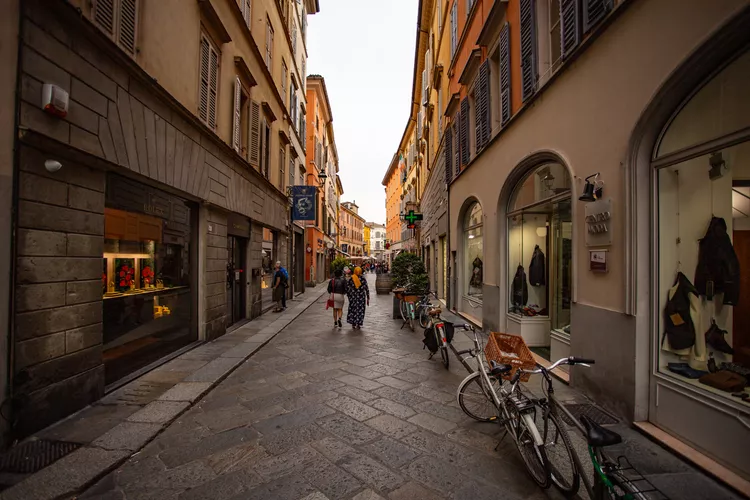Summary
Parma, in northern Italy, is renowned not only for its art and architecture but also for its exceptional culinary specialties. While it is somewhat off the radar for the millions of tourists flocking to Italy yearly, Parma is undeniably an elegant city worth exploring. With its compact historic zone, the Romanesque cathedral, and stunning 12th-century Baptistery, Parma merits at least a day, if not two or three, of your travel itinerary.
Parma Location & Transportation
Parma is situated in the Emilia Romagna Region, nestled between the Po River and the Apennine Mountains, positioned south of Milan and north of Florence. Notable cities nearby include Modena, Bologna, Reggio Emilia, and Piacenza.
For those traveling by train, Parma is conveniently located on the line from Milan to Ancona, with a few daily direct trains connecting to and from Rome. Alternatively, travelers might need to change trains in Bologna. If you’re considering driving, you can reach Parma via the A1 Autostrada. Although parts of the city, particularly the historic center, enforce traffic restrictions, pay parking lots are readily available nearby. Moreover, free parking lots located outside the city are well connected to the city center by a shuttle bus service. Parma boasts an efficient public transport system, with buses operating within the city and to surrounding areas.
What to See in Parma
The tourist office is conveniently located at the town hall, or comune, situated at Piazza Garibaldi 1.
- The Cathedral of Parma is a prime example of Romanesque architecture, completed in the 12th century. Its unique octagonal dome, guarded by lions at the porch, and capped by a gilt copper angel, reflect its remarkable design. Visitors can admire the lavishly decorated interior that includes extraordinary frescoes, especially the cupola painted by Renaissance master Correggio.
- The Baptistery, constructed from pink marble, dates back to the 12th century and features an octagonal shape. Initiated in 1196 and completed in 1307, it boasts elaborate bas-relief sculptures and intricately decorated doors. Inside, one can find sculptures that represent the months, seasons, and Zodiac signs.
- The Diocesan Museum showcases artifacts from the Middle Ages.
- The National Gallery (Galleria Nazionale), located within the expansive Palazzo della Pilotta complex, houses a diverse collection of artwork spanning the 12th to 18th centuries. Additionally, the Palazzo features the historic Farnese Theatre, an archaeological museum, a printing museum, and a library with rare books.
- The vast Piazza della Pace, located in front of the Palazzo della Pilotta, offers an open lawn, monuments to WWII partisans and Giuseppe Verdi, and the remnants of a church that was destroyed during wartime bombings, now designated by trees.
- The Palazzo del Governatore, or Governor’s Palace, situated in Piazza Garibaldi, features a beautiful facade that dates back to 1760, accompanied by a fascinating astronomical clock atop its bell tower.
- For a peaceful retreat, visit the Ducal Park, originating in the 16th century, which includes the splendid Ducal Palace adorned with outstanding frescoes.
- Parma is also home to numerous cultural events, including theater, music, and opera. The Teatro Reggio di Parma is a stunning neoclassical venue that hosts a variety of concerts and opera performances.
- Moreover, Parma offers fantastic shopping opportunities, with its main streets lined with both recognized and unique designer clothing stores, shoe shops, and jewelers. Many shops also sell traditional Parma food specialties. The elegant shopping streets, Strada della Repubblica and Strada Cavour, are teeming with bars, gelaterias, and restaurants featuring outdoor seating, ideal for people-watching.
Food Specialties in Parma
The Parma region is celebrated for its exceptional ingredients, notably the renowned Prosciutto di Parma and the world-famous cheese known as Parmigiano Reggiano. Visitors can indulge in delectable pasta dishes, browse vibrant food markets, and enjoy various wine bars and outstanding restaurants. Many tour providers also feature food-centric half-day, full-day, or multi-day tours exploring Parma and its surrounding farms.
Where to Stay in Parma
Parma’s centro storico (historic center) is compact and flat, making it easy for visitors to explore major sights on foot, no matter where they choose to stay. Hotel Torino stands out as a well-managed three-star property with a modern annex situated conveniently off Strada Cavour. For a more luxurious option, Park Hotel Pacchiosi is a five-star hotel located just outside the center, about a 15-minute walk to Piazza Garibaldi. Additionally, a range of affordable hotels are clustered near the train station, which is only a 20-minute stroll to Parma Cathedral.
Near Parma – Castles, Villas, and Mountains
Between the Po River and the Appennino mountain range south of Parma, history buffs can discover a series of beautifully preserved castles from the 14th and 15th centuries, well worth a visit for those traveling by car. In addition, several villas are open to the public for exploration. The nearby Apennine Mountains are perfect for hiking, outdoor activities, and enjoying stunning landscapes.
This article was updated and expanded by Elizabeth Heath.





